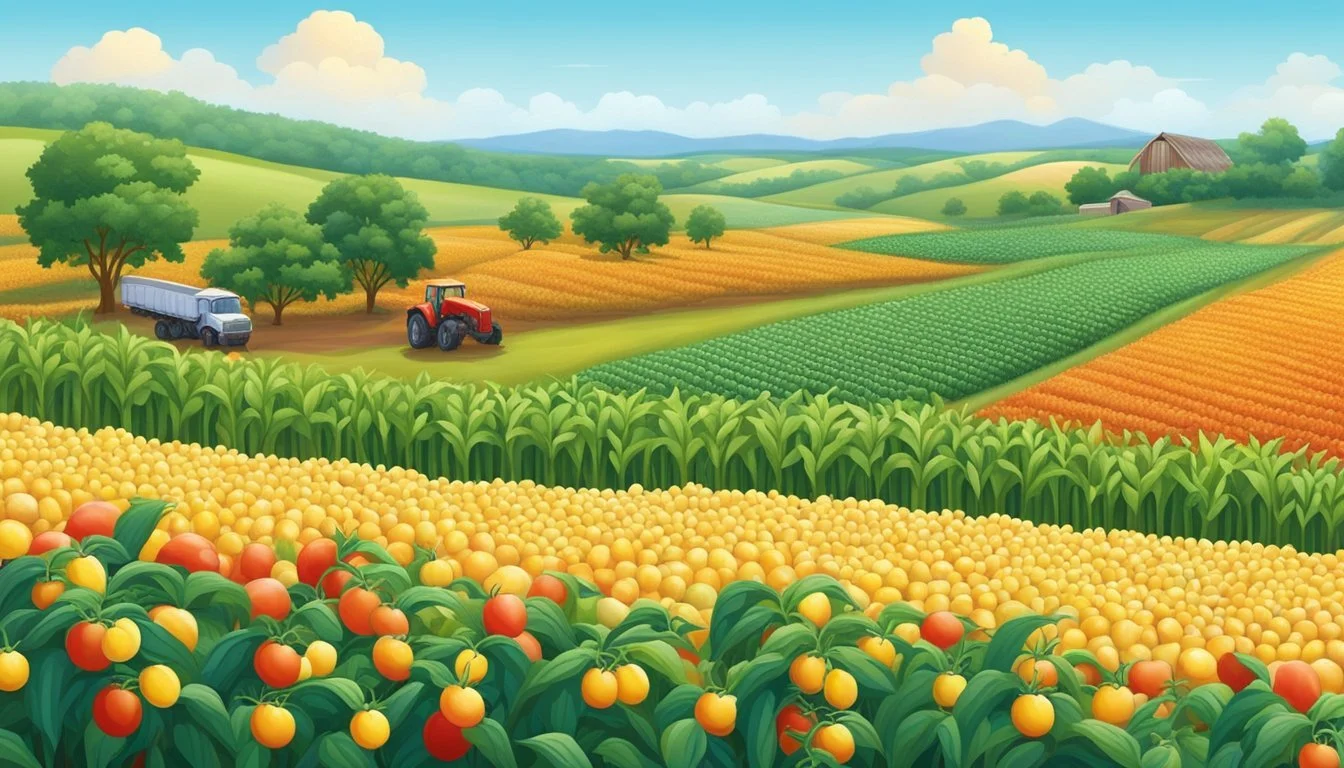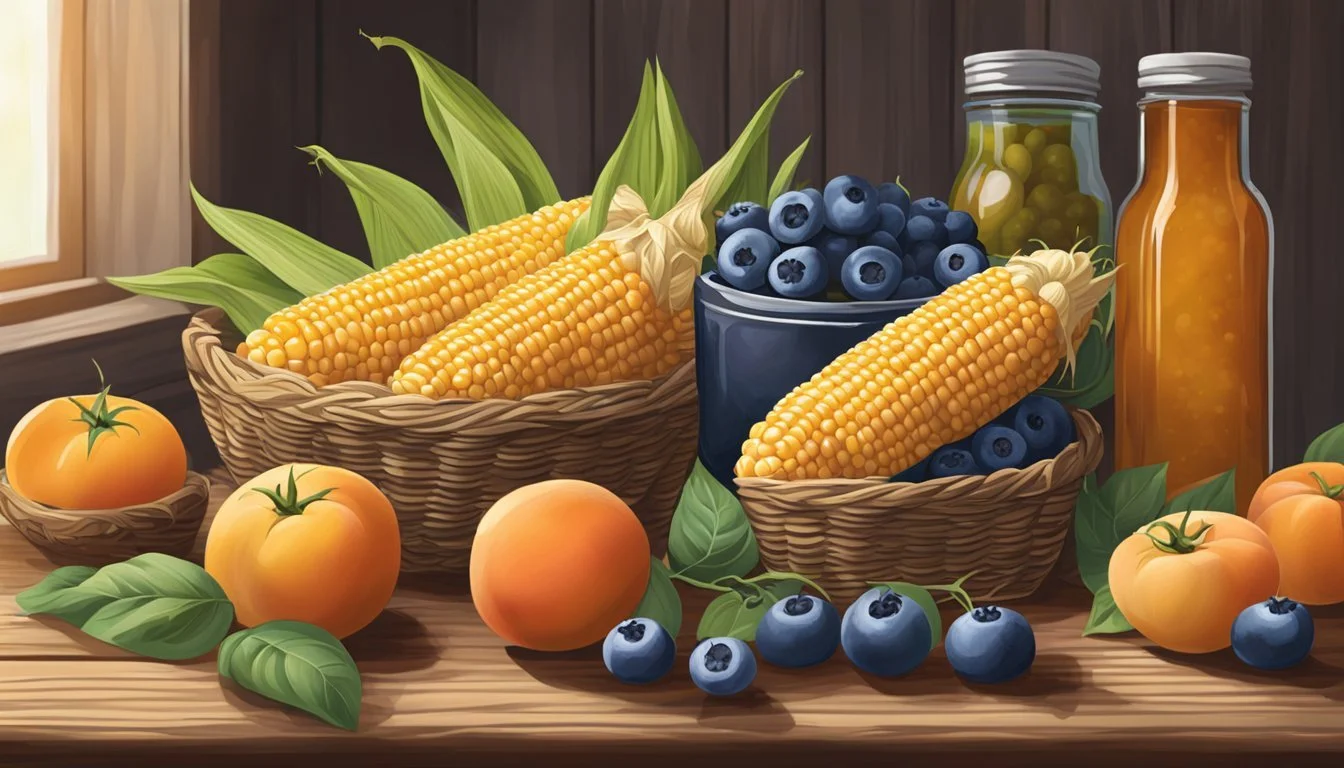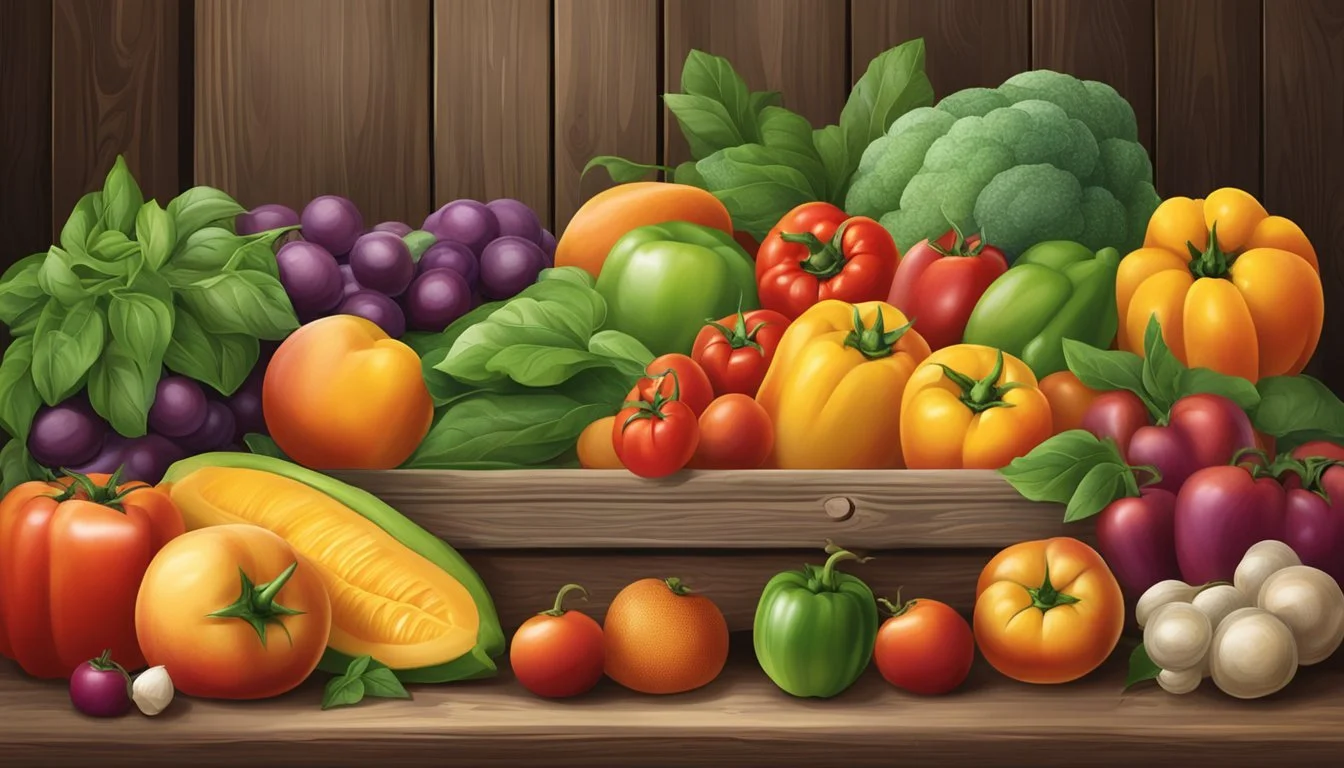Illinois Seasonal Fruit & Vegetables in July
Your Fresh Guide
This Article is Part of our Illinois Seasonal Fruit & Veg Calendar
Illinois, with its rich soil and varied climate, offers a bounty of fresh fruits and vegetables throughout the year, with July being an especially abundant month. During the warm summer days, the state's farms and gardens yield a particularly diverse and flavorful array of produce. Consumers can relish the peak of freshness and nutrition as the local markets and roadside stands become vibrant and brimming with the season's best.
The month of July ushers in a full swing harvest of both fruits and vegetables. Among the fruits, one can find a range of berries—including blueberries (how long do blueberries last?) and blackberries (how long do blackberries last?)—alongside staples such as peaches, melons, and the beginning of the apple season. These fruits, known for their juicy and sweet flavors, are not just perfect for fresh eating but also ideal for jams, pies, and summer salads.
Vegetables also take center stage with an assortment that includes crisp cucumbers (how long do cucumbers last?), zucchini (What wine goes well with zucchini?), sweet corn, and green beans. These vegetables are versatile in the kitchen, serving as the backbone for summer grills, refreshing salads, and light, healthful meals. Eating locally and seasonally in Illinois during July not only supports the local economy and reduces food miles but also provides consumers with the best taste and nutrient-rich produce.
Overview of Illinois' Seasonal Crops
July in Illinois is a time when the state's agricultural richness is in full swing, with a variety of fruits and vegetables reaching peak ripeness. This is when the summer's warmth has allowed a diverse array of crops to flourish and become ready for harvest.
Fruits that are in season during this month include juicy peaches and blueberries, which are perfect for both fresh consumption and pie-making. Melons, an iconic summer fruit, are also harvested around this time, offering a refreshing taste during the hot summer days.
Vegetables are not to be overlooked, as many staple crops reach maturity. Among these are tomatoes and sweet corn, which are ubiquitous at Illinois farmers' markets and roadside stands. The state's soil and climate conditions also favor the growth of green beans, zucchini, and cucumbers.
For those interested in the local offerings, here is a concise list of what one can expect from Illinois in July:
Fruits:
Peaches
Blueberries
Melons
Vegetables:
Tomatoes
Sweet Corn
Green Beans
Zucchini
Cucumbers
One should note that the availability of these crops can vary slightly each year, depending on weather patterns and other regional agricultural factors. Nonetheless, these fruits and vegetables serve as a testament to the bounty that the summer season brings to Illinois.
Fresh Fruit Availability in July
In July, Illinois offers an abundant selection of fresh fruit. Local markets are particularly rich with stone fruits, berries, and melons, presenting a peak season harvest that promises freshness and flavor.
Stone Fruits
Peaches: These juicy fruits are at their peak in July. Illinois peaches are known for their sweetness and can be found in abundant supply.
Nectarines: Similar to peaches in flavor and texture, nectarines are also readily available and perfect for summer snacking.
Cherries (how long do cherries last?): Cherries reach their prime harvesting period in July. The Illinois climate allows for a sweet and plump crop, ideal for both eating fresh and for baking.
Berries
Blackberries: These nutrient-rich berries are harvested in July. They're often used in Illinois for pies and jams, or eaten by the handful.
Blueberries: A favorite for their antioxidant properties, blueberries are ripe for picking throughout the month.
Raspberries: With a delicate balance of sweet and tart, raspberries are at their best and can be found fresh in local markets.
Melons
Watermelons: Synonymous with summer, watermelons are in full swing. Illinois-grown watermelons are known for their deep red color and refreshing taste.
Garden Vegetables Peaking in July
July is a prime month for harvesting a variety of garden vegetables in Illinois. The warm weather allows for a full bloom of flavors and textures, perfect for summer meals.
Green Vegetables
In July, gardeners can expect to see an abundance of green vegetables. These typically include:
Beans: Rich in flavor, they can be harvested throughout the month.
Cucumbers: Crisp and refreshing, these are ideal for salads and pickling.
These vegetables not only add a fresh crunch to dishes but also provide essential nutrients and are versatile in culinary use.
Root Vegetables
The group of root vegetables reaching their peak in this month usually includes:
Squash: Varieties like zucchini are in abundance.
Corn: Ears of sweet corn become ripe for picking and feature a signature sweetness.
Root vegetables have a robust growth during the summer months and can be used in an array of cooking styles from grilling to roasting.
Nightshades and Gourds
July also sees the ripening of nightshades and gourds. Key vegetables here are:
Tomatoes: These come in all sizes and are perfect for salads, sauces, and sandwiches.
Eggplant (What wine goes well with eggplant?): With its meaty texture, it's great for grilling or baking.
Nightshades like tomatoes are sensitive to frost and so fully benefit from July's warmth, while gourds such as zucchini offer a bounty of options for summer recipes.
Preparing and Preserving July Produce
In July, Illinois’s abundance of fresh produce offers a unique opportunity for preservation. Using methods like canning, pickling, and freezing ensures that the vibrant flavors of summer can be enjoyed throughout the year.
Canning and Pickling
Canned jams and salsas harness the ripe flavors of July fruits and vegetables. When preparing these items, it's important to use a tested recipe from a reliable source to ensure safety and the best taste. For example:
Jam: Mash ripe fruits such as berries and use a water bath canning method to seal the flavors.
Salsa: Combine diced tomatoes, peppers, and onions, then can using a pressure canner to prevent spoilage.
Pickles are another popular option. Fresh cucumbers can be turned into crisp dill (how long does dill last?) or sweet pickles through a simple vinegar brine and canning process.
Freezing and Storing
For many, freezing is the simplest way to preserve July's bounty. Vegetables like green beans and broccoli should be blanched before freezing to maintain texture and flavor. Sweet corn can be removed from the cob and frozen for a taste of summer in the colder months.
Fruits can be frozen whole or sliced. Before freezing:
Clean thoroughly
Dry to prevent ice crystals
Place on a baking sheet to freeze individually
Transfer to airtight containers or freezer bags
This method is ideal for making smoothies or as toppings for desserts.
Cooking and Baking
July produce can be immediately incorporated into cooking and baking for fresh, seasonal meals. Hearty vegetables like beets can be roasted to serve as a side dish, and summer squash adds a delicate flavor to quick breads or muffins.
Fruits can be turned into sweet compotes and used over ice cream or mixed into yogurt. For a quick dessert, bake a fruit crisp or cobbler with July peaches or berries for a showcase of summer sweetness.
Incorporating seasonal produce into meals not only enhances the flavor but also adds nutritional benefits from the fresh harvest.
Discover Community and Farmers' Markets
July in Illinois is abundant with fresh produce, and local community and farmers' markets are vibrant destinations for shoppers. These markets are not just places to purchase fresh fruits and vegetables; they are also community gatherings that offer a variety of local products including preserves, artisan cheeses, and breads.
Shoppers can find markets in operation throughout the state, catering to urban centers and rural towns alike. Illinois' oldest farmers' market, for example, offers a rich assortment of fresh picks. Beyond shopping, these markets help in fostering local economies, supporting small farmers, and promoting sustainable practices.
Illinois community and farmers' markets in July typically feature:
Fruits: Apples, Berries, Melons, Peaches, Plums
Vegetables: Corn, Cucumbers, Eggplant, Greens, Herbs, Lettuce, Okra, Tomatoes
Visitors to these markets can expect:
Local Produce: Fresh, seasonal items directly from Illinois farms.
Varied Vendors: A range of stalls selling everything from fruits and veggies to specialty goods.
Community Engagement: Opportunities to learn about local agriculture and meet the growers.
Markets usually operate one to two days a week, with some larger cities offering daily markets or ones with extended hours. Consumers are encouraged to check schedules and locations to plan their visits.
The Illinois Farmers Market Association provides resources to find markets and information on seasonal produce, ensuring visitors can locate the freshest options. By integrating community and farmers' markets into their routines, Illinois residents and visitors not only enjoy peak-season produce but also contribute to the vitality of their local communities.
Health Benefits and Nutritional Values
July in Illinois offers an abundance of summer fruits and vegetables, each with unique health benefits and nutritional profiles. Consuming a variety of these seasonal produce can contribute to a well-rounded diet.
Fruits like cherries and berries are rich in vitamins, antioxidants, and fiber. They aid in fighting inflammation and may improve heart health. Cherries, for example, contain melatonin which can help regulate sleep patterns. Berries, including blueberries and strawberries, are high in vitamin C and antioxidants known as flavonoids, which support the immune system.
Peaches and nectarines are juicy options that provide vitamin C, potassium, and fiber. These nutrients are crucial for maintaining healthy digestive and cardiovascular systems.
Melons, such as cantaloupe (how long does cantaloupe last?) and watermelon, offer hydration due to their high water content. They also supply essential vitamins like A and C, which are important for skin and immune health.
Vegetable Key Nutrients Health Benefits Tomatoes Lycopene, vitamins C and K Supports heart health and provides antioxidant protection Corn B vitamins, magnesium, phosphorus Energy production, heart health Cucumbers Vitamin K, magnesium, potassium Hydration, skin health, and maintains blood pressure Eggplant Fiber, vitamins B1 and B6 Digestive health, brain function
These vegetables contribute to a balanced diet and offer a variety of benefits. Tomatoes, rich in lycopene, are known for their role in reducing the risk of heart disease and certain cancers. Sweet corn, while sometimes debated for its sugar content, offers essential B vitamins for energy. Cucumbers, with their high water content, are perfect for hydration and skin health. Lastly, eggplants provide dietary fiber and vital nutrients to support brain health.
Gardening Tips for Illinois Residents
In Illinois, July is a critical month for both maintenance and vigilance in the garden. With high temperatures and potential pest activity, gardeners must be proactive to ensure a healthy yield.
Planting and Maintenance
Container Gardens: For residents with limited space, container gardening offers a flexible solution. They should ensure adequate drainage and choose containers large enough to accommodate growing roots.
Watering: July's heat necessitates consistent watering. Gardeners should provide deep watering early in the morning to minimize evaporation and support root health.
Mulching: Applying a layer of mulch helps retain soil moisture and regulate temperature. An organic mulch layer of 2-3 inches is recommended.
Community Gardens: Participants should collaborate on scheduling planting and maintenance efforts. Shared responsibilities can include:
Weeding: Regular weeding prevents competition for nutrients and water.
Succession Planting: Replacing harvested crops with new seedlings ensures continuous production.
Pest and Disease Control
Prevention: It's easier to prevent pest infestations and diseases than to treat them once they've taken hold. Gardeners should inspect plants regularly for signs of distress.
Insect Pests: Use insecticidal soap or neem oil as environmentally friendly options if pests are detected.
Disease: Crop rotation and proper spacing allow for air circulation and reduce the likelihood of disease spread.
Community Garden Specifics:
Communication: Gardeners should communicate about any pest or disease issues to coordinate an integrated approach to control.
Sanitation: Keeping the area clean by removing diseased plant matter reduces the risk of spreading problems.
Proper planning and upkeep are essential for gardening success in Illinois's July heat. By following these specific measures for planting, maintenance, and pest control, gardeners can enhance the health and productivity of their gardens.









